Welcome to the Knotty Blog!
Welcome to the 40 Knots Winery blog — our online space where we share the latest news, stories, and updates from our sustainable winery in the heart of Vancouver Island's Comox Valley. At 40 Knots, we take pride in crafting award-winning wines that reflect our commitment to sustainability, community, and local partnerships. Explore behind-the-scenes looks at our vineyard, and celebrate the people and initiatives that make 40 Knots unique. Whether you're a wine enthusiast or simply curious about what we do, join us in celebrating a passion for exceptional wine and sustainable living.
Want to stay more up to date? Sign up for our newsletter and get the news first!
Happy Earth Happy Life [Sustainable Wine Closures: Thoughtful Choices for Quality and the Planet]
Sustainable Wine Closures: Thoughtful Choices for Quality and the Planet
At 40 Knots Winery, every decision we make is rooted in sustainability—from how we grow our grapes to how we package our wine. One crucial choice that impacts both quality and environmental footprint is the closure we use to seal our bottles. We carefully select closures that not only preserve the integrity of our wines but also align with our commitment to sustainability. Here’s why we’ve chosen Stelvin closures, stainless steel crown caps, and Diam corks as the best solutions for our wines.
Stelvin Closures: A Reliable and Sustainable Choice
Gone are the days when screw caps were associated with low-quality wine. Today, Stelvin closures are widely recognized for their ability to preserve wine while minimizing waste. Unlike traditional corks, Stelvin screw caps eliminate the risk of cork taint, ensuring that every bottle tastes exactly as we intended. Our Stelvin closures use a Saranex liner, which provides an excellent oxygen barrier, allowing wine to age gracefully without the unpredictability of natural cork.
Sustainability is another reason we favor Stelvin closures. Aluminum is infinitely recyclable, meaning these closures can be reused without degradation. Additionally, they allow wines to be stored upright, reducing the need for additional packaging and space in cellars and stores. However, it’s important to note that while they are designed to reduce failures, storing them on their side for extended periods can eventually lead to leaks. That’s why we always recommend keeping wines with Stelvin closures upright for optimal preservation.
Stainless Steel Crown Caps: Strength and Sustainability
For our sparkling wines, we use stainless steel crown caps with bidules instead of traditional corks and cages. These closures offer an incredible seal, ensuring the wine remains perfectly carbonated until it’s ready to be enjoyed. Crown caps are the ultimate workhorse in wine closures, robust enough to withstand the aging process whether stored on their side during tirage or upright in your fridge. They also eliminate the risks associated with cork taint and oxidation.
While many associate traditional sparkling wine with the dramatic 'pop' of a cork, the truth is that cork is not the safest or most sustainable closure for these high-pressure wines. Crown caps provide a secure, controlled seal and are far more environmentally friendly than bulky cork-and-wire alternatives. They also reduce the risk of accidental cork breakage or misfires—because let’s be honest, no one wants to dodge a flying cork at a celebration!
Diam Cork: A Natural Choice with Modern Innovation
For wines where we still prefer a cork closure, we opt for Diam corks, which are made using an innovative process that shreds natural cork and reconstitutes it using beeswax. This method ensures that each cork is free from TCA (the compound responsible for cork taint) while maintaining the natural flexibility and sealing properties of traditional cork. The use of beeswax in the binding process enhances sustainability and prevents the use of synthetic glues or harmful chemicals.
Diam corks allow for consistent aging without the risks associated with conventional corks. They offer the romance of a cork closure with the reliability of a modern engineered product, making them a perfect middle ground between tradition and sustainability.
Sustainability and Longevity: Our Commitment at 40 Knots
At 40 Knots Winery, we don’t just select closures based on tradition or trends—we choose them based on their entire lifecycle’s carbon footprint. By prioritizing Stelvin closures, stainless steel crown caps, and Diam corks, we reduce waste, improve wine quality, and contribute to a more sustainable future. Each of these choices plays a role in minimizing environmental impact, whether through recyclability, reusability, or elimination of cork taint.
Caring for Your Wine: Storing It the Right Way
Wine storage is just as important as the closure itself. While traditional cork-sealed wines must be stored on their sides to keep the cork moist and prevent oxidation, Stelvin closures should always be stored upright to prevent leaks over time. Crown caps, on the other hand, are versatile and can be stored either upright or on their side without affecting the integrity of the wine.
For sparkling wines, it’s important to remember that the closure plays a key role in keeping the bubbles intact. While many assume that the traditional mushroom-shaped cork is essential for sparkling wine, it’s actually just a marketing tradition rather than the best sealing method. Stainless steel crown caps provide a far superior and safer closure, reducing waste while ensuring the celebratory ‘pop’ remains part of the experience.
Cheers to Smarter Choices
Whether you're enjoying a crisp white with a Stelvin closure, a celebratory bubbly under a crown cap, or a perfectly aged red with a Diam cork, know that 40 Knots Winery has carefully chosen each of these closures for their quality and sustainability. We take pride in making thoughtful choices that preserve the wine inside while protecting the world outside.
Here’s to sustainability, innovation, and a future filled with exceptional wines!
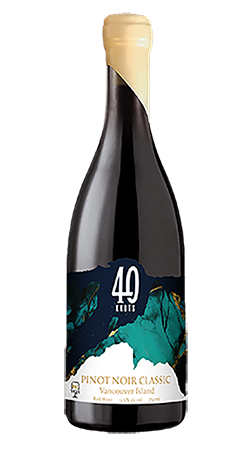



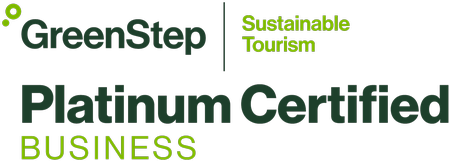
If We Had the Land, we Would Plant Hundreds of Acres of Pinot Noir
Chris Herbert #SPILLTHATWINE - read the recent publication in March's Voyager Vancouver Island Magazine.
A bottle of 40 Knots 2021 Spindrift Brut is on ice. The bubbles are chilling in anticipation of the establishment of the Comox Coastal area as BC's newest sub-GI wine region. In recognition of the area's distinctive characteristics, the sub-GI designation would envelop 63 acres of vines across nine area vineyards. This Comox peninsula boasts of glacial till and sandy, gravelly loam, the Salish Sea's moderating temperatures, and mild winters. A combination of growing conditions in which cool climate grapes thrive, producing high-quality sparkling wines, aromatic whites and Pinot Noir.
Back to those bubbles, 40 Knots traditional style 2021 Spindrift is a blend of the 777 Pinot Noir clone and Chardonnay 76 Saone-et-Loire, boasting endless tiny bubbles, crips citrus fruit on the nose followed by a tropical fruit finish.
"If we had the land we would plant hundreds of acres of Pinot Noir, as it thrives in Vancouver Island's climate and is gaining global recognition," says Layne Robert Craig, 40 Knots co-owner. With a farmer's DNA, Layne can be found in the vineyards with viticulturists, George, Andy and their fine-feathered vineyard team, or in the winery with the winemaker Kalem Magny. Kalem came to 40 Knots from the Niagara region by way of the Okanagan, arriving in 2023, and having had the opportunity to work with some very talented winemakers along the way. Kalem was drawn to 40 Knots, their minimal impact, organic farming methods, and conviction that fine wines are made in the vineyard: attributes that complement Kalem's minimal intervention, and small batch winemaking.
Kalem's winemaking style is expressed in the 2023 Classic Estate Pinot Noir. Food-friendly it will pair nicely with vegetarian plates to lean beef and will be at its best if you put it away for a couple of years.
Can't wait that long? The 2022 40 Knots' Pinot Noir is 100% 777 clone. Its sapphire colour, dark cherry and cranberry aromas combine to indulge one's senses while exhibiting a rich earthy finish. Enjoy is now alongside your charcuterie.
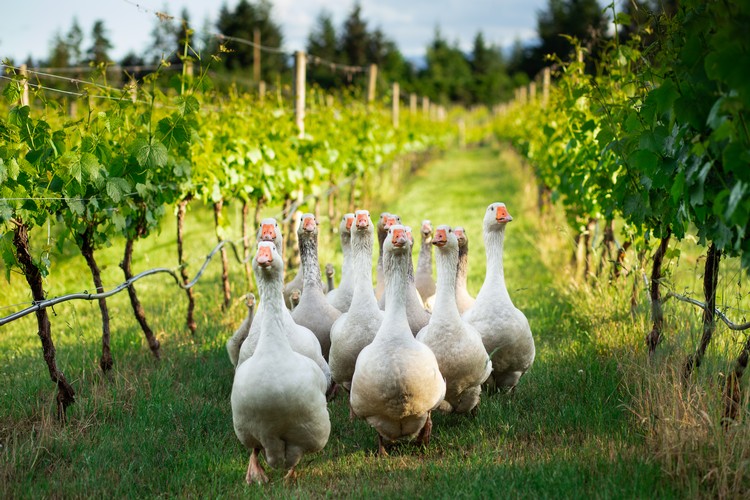
Karl MYWINEPAL [Unique Grape Varieties Making Unique Wines on Vancouver Island]
 Most of you are probably familiar with tasting BC wines made from Cabernet Sauvignon, Syrah, Chardonnay, or Pinot Gris grapes. But, there are other lesser-known grape varieties grown in BC that also make enjoyable wines.
Most of you are probably familiar with tasting BC wines made from Cabernet Sauvignon, Syrah, Chardonnay, or Pinot Gris grapes. But, there are other lesser-known grape varieties grown in BC that also make enjoyable wines.
40 Knots Vineyard and Estate Winery has made an orange wine using Schönberger and Siegerrebe grapes. As I pulled these wines from my cellar, the vintages that I am tasting are sold out and you would be purchasing the latest vintages.
40 Knots Vineyard and Estate Winery practices sustainable viticulture, focusing on low-impact farming techniques, including organic and biodynamic principles. It is quite commendable considering the cool climate where these wineries are located.
The Grape Varieties
Schönberger is a white grape variety that is a cross between Pinot Noir and Pirovano 1 (itself a cross of Chasselas Rose and Muscat d’Hamburg). This grape is prized for its intensely perfumed profile, offering layers of lychee, rose petal, and ripe pear, often with a touch of honeyed sweetness. Lastly, Siegerrebe, a crossing of Gewürztraminer and Madeleine Angevine, offers sweet spices, grapefruit, and floral notes, delivering a wine that is highly aromatic yet delicate on the palate. These hybrids showcase the diversity of BC’s wine landscape, offering exciting alternatives to traditional European varieties.
My Wine Tasting Notes
40 Knots Vineyard and Estate Winery L’Orange 2019 (BC $42 but is Sold Out. 2022 vintage)
From the winery, “Schonberger <MyWinePal: and Siegerrebe> whole berry, no crush, gentle punch downs in Amphora, terracotta from Florence, Italy. On skins for 3 months. No malolactic ferment. No additions and S02 levels below 20mg/l. No acid added, natural PH. Native fermentation, no yeast added. No fining, no filter, minimal effective sulphites.”
Appearance: A clear, deep, tawny orange colour.
Nose: Very inviting, medium-intensity aromas or candied oranges, sweet spices, and a touch of floral. Lychee aromas are now a quite prominent addition after decanting.
Palate: Dry, medium-plus body with a lean, smooth mouthfeel. Oranges, black currants and black currant leaf flavours, along with a touch of floral and some bitterness toward the finish. Medium acidity and tannins. The wine is more round after decanting and you get a touch of lychee flavour.
Finish: A medium-plus to long length, finishing dry with firm tannins. Oranges and black currant flavours plus a touch of floral and bitterness. No change to the finish after decanting.
A wine that holds its aromas and flavours after decanting and over many years in the bottle.
Rating: [4.5 stars] The 40 Knots Vineyard and Estate Winery L’Orange 2019 showcases a deep tawny orange hue with inviting aromas of candied oranges, sweet spices, and floral notes, with lychee emerging after decanting. On the palate, it is dry and medium-plus bodied with a lean yet smooth mouthfeel, offering flavours of oranges, black currants, and a touch of bitterness, becoming rounder with air. A medium-plus to long finish highlights firm tannins, oranges, and floral notes, remaining unchanged after decanting.
Past Tasting of These Wines
Here are my tasting notes from three years ago. Let’s see if there are any changes to the aromas and flavours after three more years in the bottle.
40 Knots Vineyard and Estate Winery L’Orange 2019 – This wine has a deep clear copper colour. Rich sweet nose with oranges and sweet spices. Dry, medium plus body with a thicker mouthfeel to start but lightens up on the mid-palate. Tannins kick in the mid-palate. Oranges, apple skin and sweet spices on the palate. Dry tannic finish. Medium length. A complex wine. Geek-worthy. [4.5 stars]
Comparison of the 40 Knots Vineyard and Estate Winery L’Orange 2019 Notes
Both tasting notes for the 40 Knots Vineyard and Estate Winery L’Orange 2019 highlight its deep orange-hued appearance and inviting aromas of oranges and sweet spices. Both also agree on the wine’s dry style, medium-plus body, and noticeable tannins on the finish.
Differences appear in the descriptions of mouthfeel and flavours. My newer note describes a lean yet smooth texture that becomes rounder with air, while the 2022 note mentions a thicker mouthfeel that lightens on the mid-palate. The flavour profile in the recent note includes black currants and a touch of bitterness, while the older note highlights apple skin. Additionally, the 2022 review describes a dry, tannic medium-length finish, whereas the newer review extends the finish to medium-plus to long, emphasizing citrus and floral elements.

The Swallow's Arrival
The Swallow
(Stelgidopteryx serripennis)
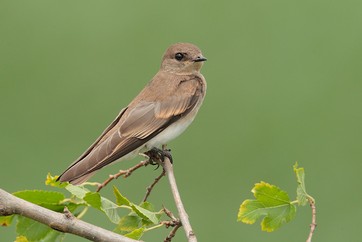
If you've ever purchased a bottle of 40 Knots wine from our cellar door, you may have noticed the Northern Rough-Winged Swallow that adorns our Estate label. The swallow is endemic to our area and frequent our vineyard. Each year we celebrate their arrival because, for us, they are not only our friends but a part of our biodynamic crew. Swallows will only live in areas that surround biodynamic balance and their presence speak volumes that our clean, green vineyard practices are working. The swallow is an excellent bug predator. Unlike other species of birds, they will never harm our grapes. 40 Knots Vineyard is surrounded by farming land and swallows always nest near other farm animals. Next time you're here, perhaps during a guided or self-guided vineyard tour, keep your eyes peeled for swallow birdhouses built to keep the birds safe and give them a home to return to every year.

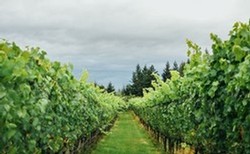
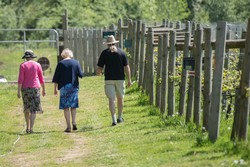
Swallows are also songbirds, and in maintaining balance it is believed that sound vibrations are important to vine health. Italy has been piping opera out into their vines for many years, and the proof shows that vines closer to the music are the healthiest in the vineyard. At 40 Knots, our version of this is offered not only to our vines but to our guests as well. If you haven't yet had a chance to partake in one of our vineyard terrace Wine Wednesday events, better book now before reservations fill up!
40 Knots is just a stone’s throw away from the Salish Sea. Because our land was created by a glacier, our vines are reaching down through glacier till soil. The rich salt air flows through our vines keeping them aerated, healthy and strong, and the salt air imbeds our oak providing beautiful aging that cannot be accomplished in dry wine regions. While walking the interpretive trail or sipping on our vineyard terrace or balcony overlooking the vineyard, you can hear the swallows singing alongside the sea lion’s barking at the arrival of the new day.
Swallows are an important friend of sailors and are believed to be a good omen. Sailors will often get a swallow tattoo to show off their sailing experience. According to one legend, one swallow symbolizes successful journeys adding up to 5,000 nautical miles, two swallows symbolize 10,000 nautical miles and so on. Another legend is that since swallows always return to the same land each year to mate and nest, the swallow will guarantee the sailor returns home safely. Sailors also believe that if they were to drown, the swallow will carry their soul to heaven.
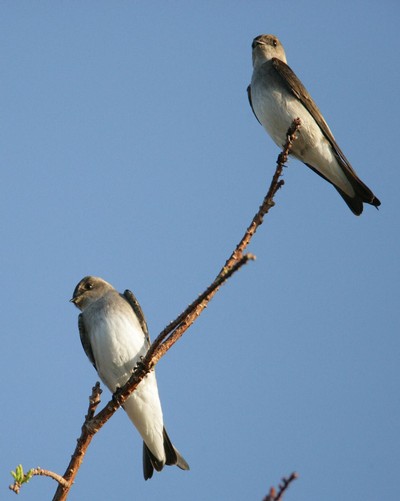
Awaiting our much-loved swallows, budburst in the near future and the days lasting a little bit longer, you better believe that we're dusting off that patio set!
Introduction to Fortified Wine Tasting
The History of Port and the Fortification of Wine
Origins of Fortified Wine
Fortified wine originated as a solution to a practical problem: preserving wine during long sea voyages. Before modern refrigeration and preservation techniques, wines often spoiled when exposed to fluctuating temperatures, oxygen, and bacteria during transport. Adding a distilled spirit, typically brandy, to the wine stabilized it by increasing its alcohol content and halting fermentation, thereby preserving its flavor and preventing spoilage.
The technique of fortifying wine began in the Mediterranean region, where trading routes spanned long distances. While the exact origins are debated, the practice was documented as early as the 16th century. Portugal, Spain, and Italy were among the first countries to adopt this method, creating distinct styles such as Port, Sherry, and Marsala.
The Birth of Port Wine
Port wine, specifically, is a fortified wine from the Douro Valley in northern Portugal. Its creation is deeply tied to the trade relationship between Portugal and England.
Why Fortification Was Necessary:
During the 17th century, the Anglo-French wars disrupted England’s access to French wines. Seeking an alternative, English merchants turned to Portugal. However, the Portuguese wines often spoiled during the long voyage to England. To address this, winemakers began adding aguardente (a neutral grape spirit) to the wine during fermentation.
The Role of Monasteries:
The earliest documentation of fortified Port-style wine comes from Portuguese monasteries in the late 1600s. Monks had been experimenting with adding spirits to wine to create a sweeter, more robust product, as well as to preserve it.
British Influence on Port:
By the early 18th century, British merchants had formalized the production and trade of Port wine. The Methuen Treaty of 1703 reduced tariffs on Portuguese wine imports to England, further popularizing Port in Britain. English trading families like Taylor, Croft, and Warre established Port houses in Portugal, which still exist today.
How Port Is Fortified
The hallmark of Port wine is its sweet, rich character. This is achieved by fortifying the wine before fermentation is complete, leaving residual sugar in the wine. The process involves:
Fermenting the grape must for a few days.
Adding aguardente to the fermenting wine to halt fermentation.
Aging the fortified wine in barrels or tanks, depending on the desired style (e.g., Ruby, Tawny, Vintage).
Other Early Fortified Wines
While Port is among the most famous fortified wines, other regions developed their own styles:
Sherry (Spain): Fortified after fermentation, producing a range of styles from dry (Fino) to sweet (Pedro Ximénez).
Marsala (Italy): Fortified during or after fermentation, often used in cooking and as a dessert wine.
Madeira (Portugal): Fortified after fermentation, subjected to heat to mimic aging during long sea voyages, resulting in its unique oxidative character.
Who Fortified Wine First?
Determining who first fortified wine is challenging due to limited records, but it is believed that:
Ancient civilizations, such as the Greeks and Romans, may have experimented with adding substances like honey or resin to preserve wine.
Distilled spirits became widely available in Europe during the Middle Ages, paving the way for intentional fortification.
The Portuguese were among the first to standardize the process, particularly in creating Port wine, due to their close ties with England and the challenges of exporting wine.
Why Fortify Wine?
Preservation: To stabilize wine for long voyages.
Enhanced Flavor: Fortification often results in a richer, sweeter product, appealing to consumers.
Trade and Economics: Fortified wines were lucrative commodities, particularly in regions like Portugal and Spain, which relied on exports for economic stability.
Fortified wines like Port became cultural icons, valued for their durability and distinct taste, and continue to be celebrated worldwide for their historical and gastronomic significance.
Join us on December 17th, 2024 to study and taste white, ruby and tawny fortified wines. Alumni grads get to bring a friend for free. If you are an alumni, please call to book in your #2 free. 1-855-941-8810 ext 103
Lessons in Knotty [How to dress for Fall on Vancouver Island]
How to dress for fall on Vancouver Island:
Socks and sandals are a Canadian classic, but why stop there? Throw in a pair of flip-flops—because, honestly, who needs logic when you’ve got style that turns heads and ankles?
Waffle knits are definitely a vibe this season, but make sure it’s a nice merino wool. These magical undershirts layer perfectly over a t-shirt that you already know won’t match, but hey, you’re a fashion rebel.
If you're feeling bold, slip into a wool onesie. Nothing says “I’m ready for anything” like flaunting that onesie underneath a pair of ripped jeans. Bonus points if the holes in the knees really show off your cozy base layer—because how else will people know you're the comfiest person in town?
Toques are essential, and the rule is simple: the more mismatched, the better. You’re not just wearing a hat—you’re sending a message. That message? "Fashion is what I say it is."
Mittens, though not actually needed, should make an appearance. Top them off with a sparkly, oversized ring, because your hands deserve to be glamorous while pretending you’re cold.
Scarves? Oh, you better believe it. Knit them yourself or grab the chunkiest one you can find. Fringe is mandatory—it adds flair and doubles as entertainment on a windy day.
Insulated vests: they might not actually keep you warm, but they’re perfect for showing off your 2023 lift pass. Nothing says, "I skied once and I’m not over it" quite like a lift ticket permanently attached to your zipper.
And remember, never use an umbrella. We don’t care if it’s raining sideways, you’re on Vancouver Island. You embrace the drizzle. Umbrellas are for tourists, and you’re here to prove that getting soaked builds character!
Layne Craig of 40 Knots winery reflects on the last 10 years
Layne Robert Craig, Owner
an interview with Carl
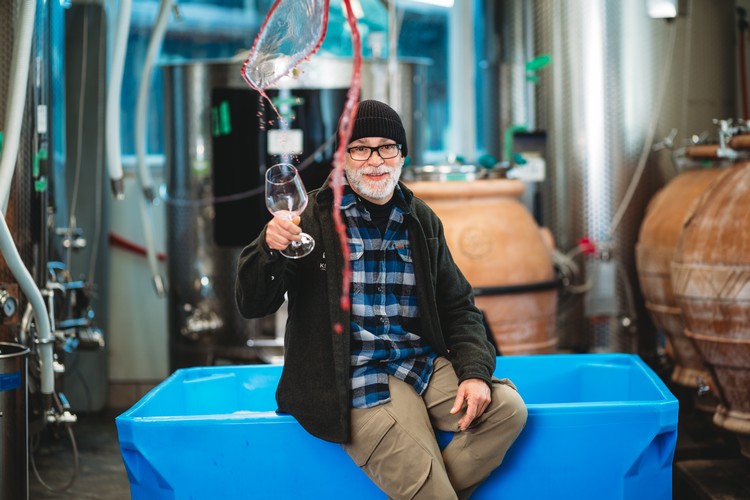
Layne is celebrating his 11th year in the industry, Layne has two loves: his wife, Brenda, and his mistress—the grapes. Layne listens to his mistress with devotion, taking her orders directly and ensuring every whim is met. You’ll often find him interrupting cellar time for impromptu tours. His mission? Keep the workload light, because when you trust the grapes, they make the perfect wine on their own. Layne’s here to ensure everything runs smoothly (and get a taste test along the way). Media Inquiries: brenda@40knotswinery.com | /
What’s the ONE THING most unique, authentic, & memorable about your brand?
At 40 Knots, we stay true to our roots—literally and figuratively. Our name reflects the fierce coastal winds and the stall speed of my plane (my favorite flying moment, while my wife Brenda is screaming in the front passenger seat!). We honor traditional farming and winemaking, crafting wines as serious and beautiful as our label suggests. But behind the scenes? We’re a knotty, adventurous crew who play as hard as we work. Whether we’re tending the vines, losing spectacularly in softball, or “quality testing” the bubbles a bit too much, we bring joy and laughter to everything we do. Each sip of our wine is a bold celebration of nature, craftsmanship, and the cheeky spirit of our fun-loving team.
Describe how and what you’d do with your winemaking career or winery business if you were not constrained. Sky’s the limit!
If there were no limits, we’d go all in and plant a ridiculous amount of Pinot Noir, letting it rule the vineyard like the diva it is. Every single berry would get the royal treatment, fermenting and aging only in amphora because, let’s face it, nothing else captures the essence quite like it. Picture a massive underground glass cellar, 14 feet deep and a mile long, where guests can spy on the glacier till soil and roots that look like something from a sci-fi film. We’d age wines for 20 years or more, just to make our future selves proud. With endless staff on hand, we’d spend our days hanging out with our incredible customers, drinking and laughing together until the sun sets (and maybe a little after that, too). The sky’s not just the limit—we’re aiming for the stars, baby.
What is the One Wine most emblematic of your brand and/or winemaking style? Tell us its story.
Without question, it’s our Pinot Noir—a wine that every winemaker measures themselves against. I’ve always thought of Pinot as a woman: delicate, demanding, and a healer, offering more medicinal properties than any other red grape. But once she becomes wine, she takes on a masculine side—full of structure, sophistication, and mystery, like a suave 007. At 40 Knots, we respect the Pinot. You don’t fight her in the vineyard or cellar—Pinot is the boss. She’s allowed to be what she’s destined to be: an oceanside Pinot, a true reflection of our natural winemaking style. Stay tuned for this wine review, coming soon!
What’s the one thing people would be surprised to learn about your brand?
The one thing that surprises people about 40 Knots Vineyard is that yes, we do have a vineyard, and yes, our grapes thrive! Despite being in Canada, we’re far from the igloos many envision. Instead, we have sandy beaches, rainforest-like hiking trails, and a microclimate where Pinot Noir flourishes. It’s not the cold, snowy tundra you might expect—it’s a stunning coastal haven that’s perfect for growing beautiful fruit.
about Carl
I don’t have any superpowers when it comes to wine, but I do have access, a mild obsession, an interest in visiting wine regions, and a love for storytelling. Wine people have some great stories to tell.
For 15 years as a publicist in the wine business, I have pitched, cajoled, and collaborated with the Wine Media. It has taken me to this place: wanting to share the compelling stories of winemakers by providing writers with a source of useful story ideas.
I have written wine industry articles for Wine Business Monthly, Wine Industry Network, Vineyard & Winery Management Magazine, The Grapevine Magazine, and Oregon Wine Press, and have had a Wine Writer Interview Series on Wine Industry Advisor for over 5 years.
I also write freelance wine and travel articles for Winetraveler, Food Wine Travel Magazine (IFWTWA (International Food Wine Travel Writers Association), Wander With Wonder, and The Vintner Project.
Author Pages: https://linktr.ee/carlgiavanti
40 Knots Achieves Biosphere Sustainable Lifestyle Certification and BC Green Business Certification
At 40 Knots Winery, sustainability is at the heart of everything we do. We are incredibly proud to announce that we have earned new certifications in sustainability to add to our Platinum Certification in Green Step and the BC Tourism Sustainability Award for 2024.
These accomplishments would not have been possible without the ongoing support of our dedicated employees, trusted suppliers, and loyal customers. Your belief in our mission has driven us to continually strive for excellence in sustainability, and we are deeply grateful for your role in helping us reach this milestone.

The Biosphere Sustainable Lifestyle Certification is a prestigious global recognition awarded to businesses that lead in sustainable practices across environmental, social, and economic pillars. Developed by the Responsible Tourism Institute (RTI) and aligned with the United Nations’ 17 Sustainable Development Goals (SDGs), this certification reflects a comprehensive approach to sustainability.
At 40 Knots, we proudly take action in reducing our carbon footprint, supporting local communities, and promoting ethical and eco-friendly practices. Through this certification, we are actively contributing to the 2030 Agenda for Sustainable Development, ensuring that we create positive impacts for future generations.
40 Knots achieves Green Status Certification with BC Green Business

BC Green Business at a level of "Green" is their highest level of recognition. As a BCGB member, we undergo annual evaluations to track our sustainability progress and make continuous improvements towards our green goals. Through the program, we work alongside over 200 like-minded businesses across British Columbia who are who are creating real change for our planet and community.

Platinum Certification with GreenStep Sustainable Tourism: 40 Knots has undergone consistent certification for 8 years with Green Step - completing a comprehensive assessment (every two years since 2015), to achieve Sustainable Tourism PLATINUM Certification, one of only three businesses in CANADA to achieve this recognition. The process includes a one-on-one review of our business practices with a Sustainable Business Advisor to see how we’re doing against criteria aligned with the Global Sustainable Tourism Council and the UN's Sustainable Development Goals.
A Call for All Businesses to Take Action
In this critical time for the health of both our planet and people, it is more important than ever for businesses to step up and embrace sustainable practices. This certification reminds us that every organization, regardless of size or industry, has a responsibility to protect the environment and support the communities in which we live and work. We encourage all businesses to take similar steps because the future of our world depends on it.
A Call for All to Take Action
Waste Reduction Week Oct 21-27: Tips to Shrink Your Footprint
We all know the mantra: reuse, repurpose, recycle. But let's add refuse and reduce to the mix for an even bigger impact on cutting waste and speeding up our move toward a circular economy. Ready to jump in? Here are five easy ways to get started:
Rethink Your Recycling:
Sorting your recycling and taking it to a professional recycling center could make a huge difference. Did you know that too many blue bins end up in landfills because they’re “contaminated”? Only 9% of plastics in Canada are actually recycled. Be part of the solution, not the statistic!
Repair, Don’t Replace:
Got something broken? Instead of tossing it, try fixing it. Reach out to the manufacturer for parts or hop onto YouTube for DIY repair tutorials. It's amazing what a little elbow grease can do to extend the life of your stuff!
Donate, Consign, or Swap Clothes:
That shirt you never wear? Someone else might love it. Donate to thrift shops, consign, or use Buy and Sell groups to give your clothes a second life. And while you're at it, consider thrifting yourself—it’s easy on your wallet and the planet.
Get Smart with Groceries:
Food’s expensive, so make it last. Invest in good storage solutions, and learn what can be frozen or dehydrated. Plan portions carefully and get creative with scraps—veggie peels and meat bones make killer broths. Leftovers? Turn them into soups, stews, or even dog treats! And don’t forget to save seeds from your produce to plant for next season.
Share the Big Stuff:
Why buy when you can borrow? Share big-ticket items like lawnmowers or camping gear with neighbors or family. Carpooling can also cut down on costs and emissions. Think community over consumption.
And finally, refuse waste before it happens! Opt for bulk purchases and bring your own containers whenever possible to cut down on excessive packaging. Every small step adds up—so let’s keep moving toward less waste and a greener future!
Special Thanks to Our Partners
This achievement also owes much to the invaluable guidance and support from the brilliant and dedicated teams at BC Green Business, Synergy Foundation, and Green Step. Their expertise and smart solutions have been key to helping us strengthen our commitment to sustainability, and we are deeply thankful for your partnership.
Thank you once again to everyone who has been part of this journey. Together, we are raising a glass to sustainability, the health of our planet, and the well-being of our communities!
Celebrations: Is it Okay to Wear Sunglasses to a Themed Wedding?


At outdoor daytime weddings, the bride and groom may even encourage their guests to bring their own sunglasses as a form of protection against the sun’s rays. After all, excessive sun exposure can result in eye discomfort and damage that can certainly dampen the wedding festivities. Overall, it is definitely okay to wear sunglasses at a wedding—provided you are mindful of your eyewear choices, especially if the wedding has a specific theme.
How to select sunglasses for a wedding
These days, wedding ceremonies and receptions have become more creative. With the various wedding themes people can choose from, including everything from fantasy to rustic setups, it is important to familiarize yourself with what the bride and groom have taken the time to select for their special day. Before anything else, check the dress code for any restrictions before selecting sunglasses that complement both the wedding theme plus your own outfit. If the dress code leans more towards the informal side, simple and casual sunglass frames will suffice. However, for more formal and extravagant weddings, it may be best to utilize sleek, black frames for some elegance.
Overall, avoid any brightly colored and flashy sunglasses that can serve as a distraction so as to not look out of place at the wedding and, more importantly, remain respectful to the couple and other guests. To get you started, here are some common but tasteful wedding themes where sunglasses can most likely be utilized, along with what type of frames would best suit the occasion.
Rustic wedding
Rustic weddings are typically inspired by the great outdoors, with a lot of focus on handmade touches. From forests with lots of leaves and branches as decor to farms that look a bit more organic and boho, rustic themes are considered a balance between thoughtful vintage pieces and country-inspired details. As such, some of the best sunglasses for this theme are those with delicate pastel-colored frames, such as the Derek Cardigan Crater and Main and Central Newton. These types of frames are some of the top eyewear trends of the year. The neutral color palette will match perfectly with a rustic wedding, as well as the love of nature the theme encapsulates.
Vineyard wedding
Vineyard weddings can range from dinner among the vines to an affair at a winery. Either way, this type of wedding is sure to provide decadent wine and gorgeous scenery to enjoy your glass with. These venues typically accommodate dining, cocktail, and long table settings depending on the number of guests and the couple’s preferences. Sunglasses with wooden frames that resemble the oak barrels used to age the wines would be a nice touch for a wedding of this theme. Some examples of these types of frames are Waidzeit Design’s Merlot, Chardonnay, and Freedom Whiskey Sunglasses. These are extremely lightweight and provide the best comfort. Additionally, the simplicity of the material and neutrality in color make them suitable for the occasion while providing a stylish touch to your wedding attire.
Beach wedding
Beach weddings are a popular choice for couples, as it allows them and their guests to strip away all the fuss that comes with a traditional wedding. More importantly, the venue provides an extremely romantic setting, with the relaxing sound of ocean waves and a beautiful view of the sunlight against the ocean overlooking this momentous event. Sunglasses will likely be encouraged at this type of wedding and may even be offered as a favor. However, if you want to elevate your appearance, opt for oversized sunglasses. Brands like Loewe have Oversized Round Sunglasses in various colors such as black, light brown, honey, and havana that are sophisticated in appearance and offer the best protection against the sun, which is very much needed in a seaside venue where not a lot of shade is available. These frames are also very common, which makes it easy to pick out details like shape and color to match the rest of the wedding theme.
While choosing the right clothes for a themed wedding is very important, don’t forget your sunglasses, as they can elevate your appearance to the next level.
What kind of wedding theme should you go for?
What kind of wedding theme should you go for?
With so many beautiful wedding options to choose from, picking the perfect theme for your wedding can be difficult. Themes are a vital aspect of planning your wedding, as they will help you to seamlessly combine the look and feel of the day. Ultimately, your theme should closely represent you and your partner's personal tastes and preferences. You can even use a theme to convey an important part of your story as a couple, or to showcase prominent features of your personalities, such as a love for nature or alternative styles.
Let's take a look at some of the most popular wedding themes to see which you most resonate with.
Bohemian, rustic or earthy
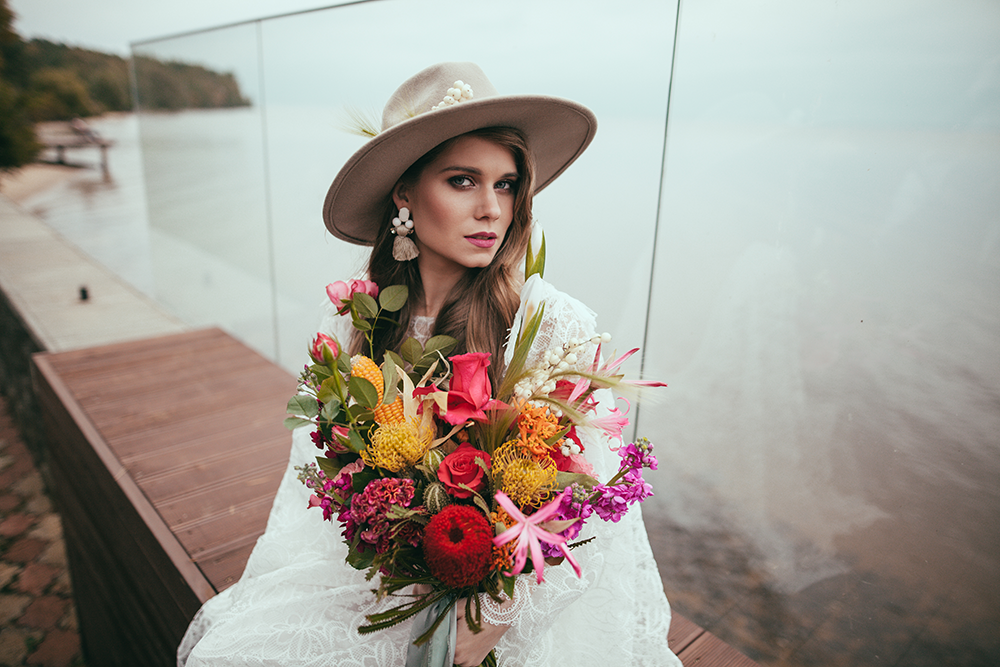
Taking your wedding outdoors and enjoying the natural world is perfect for the free-spirited and those who want a more relaxed, ethereal feel to their day. Let the trees and wildflowers be your decorations and keep your clothes simple but stunning. Choose a sustainable menu, reusable cups, and locally grown flowers to honour the planet as you wed. After the sun goes down, solar-charged festoon lighting and candle-lit lanterns can help to keep the party
going.
Beach vibes
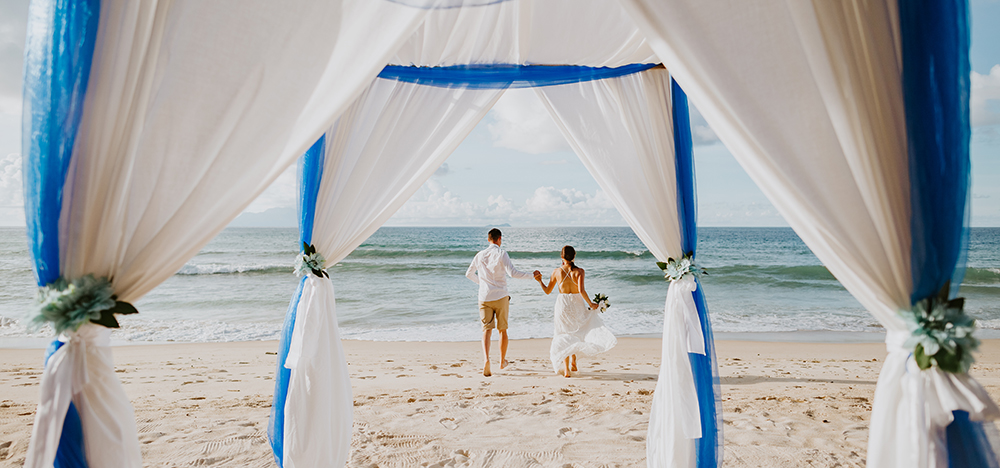
For those lucky enough to be tying the knot somewhere sunny, a beach theme may create the perfect romantic setting. Whether or not you choose to have your ceremony and/or party on the coast, you can easily incorporate beachy elements to your decor. Using feathery Marram Grass, clovers, orchids and other coastal flora in your vases will bring the waves and the sand to your venue. Create your own decor from seashells, driftwood and floaty
fabrics to enhance the dreamy beach vibes.
Gothic fantasy, steampunk or historical
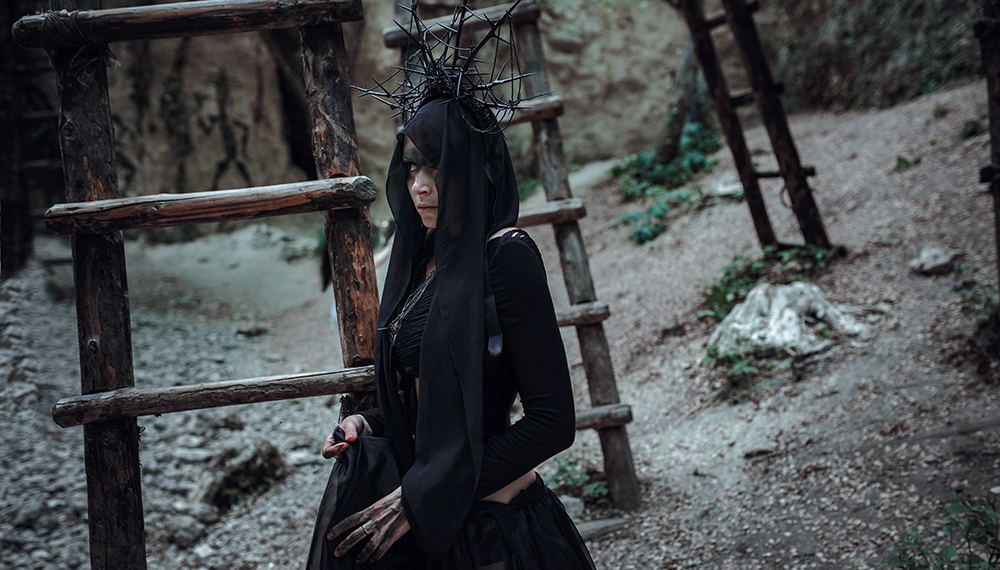
Why not step back in time and celebrate your big day by encouraging your entire wedding party to celebrate a more unconventional theme? Whether you buy or craft your own extravagant outfits, or keep them historically accurate by thrifting vintage stores, basing your theme on your favourite time period is a great way to create an unforgettable experience for all who attend. As well as being fun for everybody, you’ll be sure to get some pretty unique wedding photographs to look back on for years to come.
Country
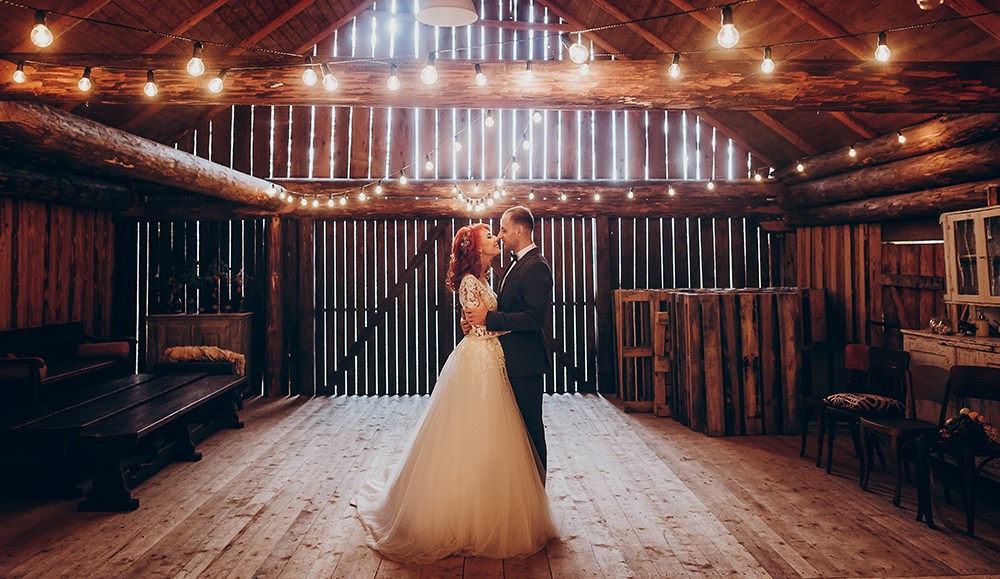
Raise the roof of a brightly lit barn for an authentic countryside wedding theme. Perfect for those interested in farming or country living, why not invite your guests for a folk-style affair complete with straw bales and tartan blankets. Warm wooden beams, real fires and a live band playing, your guests are sure to have the time of their lives in this informal, relaxed setting. Plus, look forward to some truly beautiful wedding photographs in the surrounding fields, woodlands and trees.
Unique to you

Finally, remember that this day is yours, so why not pick a theme that’s as individual as your love for each other Whether you’re both fans of horror flicks or crazy about singing, pick a theme that celebrates a passion you both share or one that brought you together, to make your wedding theme as unique as possible.


